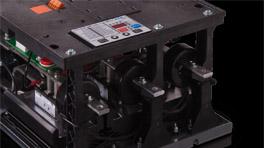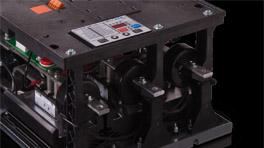Soft Starters Spare Wear & Tear on Motors, Help Control Peak Energy Usage
April 24, 2015

It's conventional wisdom in industry and manufacturing that the most wear and tear happens on machines during the stressful startup process. By some estimates, the startup process of an induction motor involves inrush currents that can be seven times higher than normal running current. In addition, startup torque can be about three times higher than running torque. These factors lead to unnecessary mechanical stress that can lead to reduced useful life as well as excess power usage, which can cause a drop in available voltage in other operations.
Soft starter technology has become a way to mitigate startup stressors by moderating a motor's voltage supply during the machine start-up phase, slowly ramping it up and effectively adjusting the machine's load behavior to protect mechanical components. Compared to other motor control solutions, soft starters can be more beneficial for applications that have loads that create a high inrush of current on the motor or loads that create inertia that can damage motors or pumps.

According to Nichole Angiola, product manager for adjustable frequency drives at Eaton's Controls and Power Conversion Division, not enough companies are considering soft starter technology today, since there is often a dual goal of extending machine life and saving energy. "When users are looking for energy efficiency solutions, soft starters have a tendency to be overlooked when converting away from standard electromechanical starters," she told Design News. "Drives are perceived to be the only motor control solution that provide energy efficiency."
This can be a mistake, however, as soft starters have a better record in long-term operations.
"When motors are only running at full speed or at full load amps, drives become less energy-efficient compared to soft starters," Angiola told us. "This is due to the integrated bypass contactor in a soft starter. When the motor is at full load amps, the soft starter removes the voltage from the SCR (silicon-controlled rectifier) and uses a bypass contactor to maintain the full voltage to the motor. This allows the device to last longer, since the voltage is not on the electronic component."
MORE FROM DESIGN NEWS: How Does an Engineer Predict Step Motor Pull-Out Torque?
For industrial organizations looking to moderate their energy usage , soft starter technology can be vital in eliminating expensive energy peaks -- something for which utility companies tend to punish industrial customers in the age of smart-grid peak demand programs. The massive inrush current that occurs when motors are started, particularly in facilities that tend to start multiple machines at the same time, gives a black eye to manufacturers trying to moderate usage.
"Essentially, the inrush current is not averaged; the multiple inrush currents add up and could double or triple the demand at that time," Angiola said. "Utility companies will penalize facilities that don't manage these incredible peak demands by charging at the highest energy rates for the full period."
The adoption of soft starter technology has benefited recently from new industry initiatives to produce machines that are easier to set up and administer. Other solutions are combining soft starter technology with soft stop functionality, which is crucial in maintaining the integrity of pumps and preventing damage from sudden valve closures.
Tracey Schelmetic graduated from Fairfield University in Fairfield, Conn. and began her long career as a technology and science writer and editor at Appleton & Lange, the now-defunct medical publishing arm of Simon & Schuster. Later, as the editorial director of telecom trade journal Customer Interaction Solutions (today Customer magazine) she became a well-recognized voice in the contact center industry. Today, she is a freelance writer specializing in manufacturing and technology, telecommunications, and enterprise software.
Design engineers, New England's premier design and manufacturing event, Design & Manufacturing New England, will take place in Boston, May 6-7, 2015. A Design News event, Design & Manufacturing New England is your chance to meet qualified suppliers, get hands-on with the latest technologies, be informed, and expand your network. Learn more here.
About the Author(s)
You May Also Like





